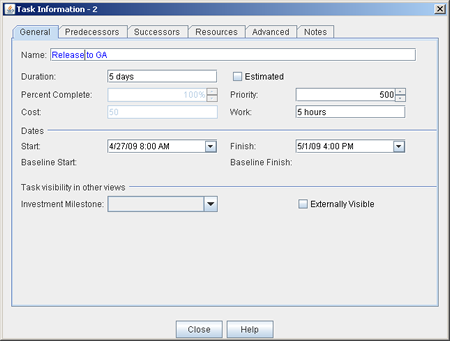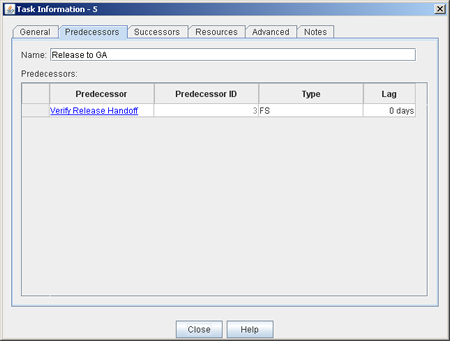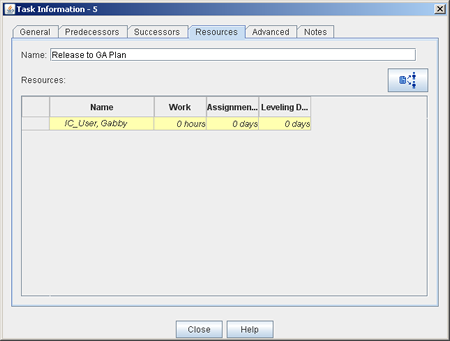Tab: Advanced
The Advanced tab in the Task Information dialog box is used to manage constraints, work breakdown structure codes, and to indicate the task type, whether the task is displayed as a milestone, whether a task ignores a resource calendar, and so on.

The following fields are available from the Advanced tab in the Task Information dialog box:
| Fields | Description |
|---|---|
| Constraint Date | The date (start or finish) upon which the constraint is based. Required for Finish No Earlier Than, Finish No Later Than, Must Finish On, Must Start On, Start No Earlier Than, or Start No Later Than. This is not used with the As Late As Possible or As Soon As Possible constraints. |
| Constraint Type | The constraint that has been set for a task. A constraint can be one of the following: As Late As Possible, As Soon As Possible, Finish No Earlier Than, Finish No Later Than, Must Finish On, Must Start On, Start No Earlier Than, or Start No Later Than. |
| Deadline | A deadline is a date in the task plan schedule by which a task needs to be completed. A deadline appears in a Gantt chart view as a diamond. |
| Display task as milestone | Indicates whether the task is displayed as a milestone task. A milestone is a task that has a duration of zero days. |
| Earned Value Method | Earned value method. This field is manually entered (and its value is not calculated). Use earned value method when there are tasks in a task plan that require physical percent complete. |
| Effort Driven | Indicates whether the total amount of work required to complete the task is directly affected by the number of resources that have been assigned to it. |
| Name | The name of a task (or a task plan). |
| Ignore Resource Calendar | Indicates whether the task, when scheduled, ignores calendars that are associated with one or more resources who are assigned to this task (or task plan). |
| Type | The task type; used to determine how work, assignment units, and durations are calculated for this task in the task plan: fixed duration (values for the task's start and finish dates are fixed), fixed work (values for the work to be completed are fixed), or fixed units (values for resources assigned to the task are fixed). |
| WBS |
Work breakdown structure. The hierarchy of tasks in a task plan. A work breakdown structure is often represented as a series of delimited numbers, letters, and/or characters, separated by period, plus, slash, and/or minus symbols. For example, 1.A.a could be the way that your organization chooses to define the sequence. When a task is the 2nd summary task in the task plan (itself with a series of summary tasks), the 3rd task for the 2nd sub-summary task would have a work breakdown structure of 2.B.c. |
Tab: General
The General tab in the Task Information dialog box is used to track durations, priorities, costs, dates, and so on.

The following fields are available from the General tab in the Task Information dialog box:
| Fields | Description |
|---|---|
| Baseline Finish | The original, planned finish date for a task (or a task plan). |
| Baseline Start | The original, planned start date for a task (or a task plan). |
| Cost | The amount of money that is spent to produce something of value. In a task plan, a cost is the amount of money that is spent while finishing a task. For example, a resource's hourly billing rate or the cost of renting a tractor (a material resource) for a day. A cost can be associated with a task, a resource, an assignment, or a task plan. |
| Duration | A duration is the total amount of time required to complete a task, based on a task's start and finish dates. A duration is always based on how a day is defined in the working calendar associated with the task plan. A day is defined (by default) as being 8 hours; therefore, a duration of 1 day in a task is 8 hours. |
| Estimated | Indicates whether the task's duration is an estimated duration. When a duration is an estimated duration, a question mark (?) will appear alongside it in the task plan. |
| Externally Visible | Indicates that this task is visible to other items within the work item hierarchy. |
| Finish | The date on which a task is scheduled to finish. |
| Item Milestone | A milestone is a special task that represents an event in your project. Any task that has a duration of zero days is considered a milestone task. |
| Name | The name of a task (or a task plan). |
| Percent Complete | The progress made against a task (or a task plan), expressed as a percentage (of 100%). |
| Priority | Indicates the importance of the task in relation to other tasks. 500 is the default value; 1000 is the highest priority and 0 is the lowest priority. The higher the number, the higher the priority. |
| Start | The date on which a task is scheduled to start. |
| Work | The total amount of work that has been scheduled for a task. |
Tab: Notes
The Notes tab in the Task Information dialog box is used to store notes that have been entered about that task.

The following fields are available from the Notes tab in the Task Information dialog box:
| Fields | Description |
|---|---|
| Name | The name of a task (or a task plan). |
| Notes | The notes that have been entered about a task (or a task plan). |
Tab: Predecessors
A dependency (often called a linked task) determines how a task in a task plan is scheduled, in relation to all other tasks in the task plan. A dependency is based on a task's start date and/or finish date. A dependency that determines how other tasks in a task plan are scheduled is called a predecessor. A dependency that relies on another task's start date or finish date to determine how it can be scheduled is called a successor.
A predecessor is a task that determines when another task (a successor) can be scheduled. The default link type for all links between tasks is finish-to-start (FS).
The Predecessors tab in the Task Information dialog box is used to manage predecessor tasks.

The following fields are available from the Predecessors tab in the Task Information dialog box:
| Fields | Description |
|---|---|
| Lag | The amount of time in the schedule that a task can be delayed before it will affect the scheduling of other tasks. Lag occurs when there is a delay between two tasks that share a dependency. |
| Name | The name of a task (or a task plan). |
| Predecessors | The unique ID for a predecessor task in the task plan. |
| Predecessor ID | The unique ID for a predecessor task in the task plan. |
| Type |
The dependency relationship to the predecessor task. FS (finish to start), FF (finish to finish), SF (start to finish), or SS (start to start). |
Tab: Resources
The Resources tab in the Task Information dialog box is used to view information about the resources who have been assigned to work on a task. You can add additional columns to the spreadsheet; right-click in the spreadsheet and insert a column. You can manage resource assignments by clicking the Assign Resources icon (to open the Assign Resources dialog box).

The following fields are available from the Resources tab in the Task Information dialog box:
| Fields | Description |
|---|---|
| Assignment Units | The amount of units for which a resource is assigned to a task. Assignment units are a percentage, where 100% is used as the maximum value. |
| Levelling Delay | The amount of time that a task can be delayed, based on its early start date. |
| Name |
The name of a task (or a task plan). |
| Work |
The total amount of work that has been scheduled for a task. |
Tab: Successors
A dependency (often called a linked task) determines how a task in a task plan is scheduled, in relation to all other tasks in the task plan. A dependency is based on a task's start date and/or finish date. A dependency that determines how other tasks in a task plan are scheduled is called a predecessor. A dependency that relies on another task's start date or finish date to determine how it can be scheduled is called a successor.
A successor is a task that has its schedule determined by another task (a predecessor). The default link type for all links between tasks is finish-to-start (FS).
The Successors tab in the Task Information dialog box is used to manage successor tasks.

The following fields are available from the Successors tab in the Task Information dialog box:
| Fields | Description |
|---|---|
| Lag | The amount of time in the schedule that a task can be delayed before it will affect the scheduling of other tasks. Lag occurs when there is a delay between two tasks that share a dependency. |
| Name | The name of a task (or a task plan). |
| Successor | The unique ID for one or more successor tasks in the task plan. |
| Type | The dependency relationship to the successor task. FS (finish to start), FF (finish to finish), SF (start to finish), or SS (start to start). |